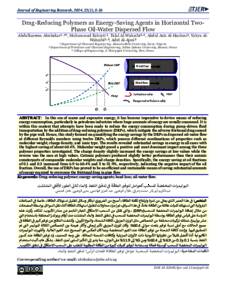Document
Drag-reducing polymers as energy-saving agents in horizontal two-phase oil-water dispersed flow.
Identifier
DOI:10.53540/tjer.vol.21iss1pp8-16
Source
Journal of Engineering Research, v. 21, no. 1, p. 8-16.
Contributors
Eshrati, Mohammad., Author
Al-Wahaibi, Talal., Author
Al-Hashmi, Abdul Aziz., Author
Al-Wahaibi, Yahya., Author
Al-Ajmi, Adel., Author
Other titles
البوليمرات المخفضة للسحب كعوامل لتوفير الطاقة في تدفق النفط والماء ثنائي الطور المتشتت أفقيًا.
Country
Oman
City
Muscat
Publisher
College of Engineering, Sultan Qaboos University.
Gregorian
2024-04-29
Language
English
Subject
English abstract
In this era of scarce and expensive energy, it has become imperative to devise means of reducing energy consumption, particularly in petroleum industries where huge amounts of energy are usually consumed. It is within this context that attempts have been made to reduce energy consumption during pump-driven fluid transportation by the addition of drag-reducing polymers (DRPs), which mitigate the adverse frictional drag caused by the pipe wall. Hence, this study focused on quantifying the energy savings by the DRPs in dispersed oil-water flow at different Reynolds numbers using twelve DRPs, which possess different combinations of properties such as molecular weight, charge density, and ionic type. The results revealed substantial savings in energy in all cases with the highest saving of about 60.4%. Molecular weight posed a positive and most dominant impact among the three polymer properties investigated. The charge density slightly increased the energy savings at low values while the reverse was the case at high values. Cationic polymers produced slightly better performances than their anionic counterparts of comparable molecular weights and charge densities. Overall, the use of DRPs has proved to be an efficient and sustainable means of saving substantial amounts of energy required to overcome the frictional drag in pipe flow.
ISSN
Online: 1726-6742
Print: 1726-6009
Arabic abstract
في هذا العصر الذي يتسم بندرة وارتفاع تكلفة الطاقة، أصبح من الضروري ابتكار وسائل لتقليل استهلاك الطاقة، خاصة في الصناعات النفطية التي تستهلك كميات هائلة من الطاقة عادةً. في هذا السياق، تم إجراء محاولات لتقليل استهلاك الطاقة أثناء نقل السوائل بواسطة مضخات عن طريق إضافة البوليمرات المخفضة للسحب (DRPs)، التي تقلل من السحب الاحتكاكي الضار الناجم عن جدار الأنبوب. ركزت هذه الدراسة على قياس توفير الطاقة بواسطة البوليمرات المخفضة للسحب في تدفق النفط والماء المتشتت عند أرقام رينولدز المختلفة باستخدام 12 بوليمرًا تمتلك تركيبات مختلفة من الخصائص مثل الوزن الجزيئي، كثافة الشحنة، والنوع الأيوني. كشفت النتائج عن توفير كبير في الطاقة في جميع الحالات مع أعلى نسبة توفير بلغت حوالي 60.4٪. أظهر الوزن الجزيئي تأثيرًا إيجابيًا وكان الأكثر هيمنة بين الخصائص الثلاثة التي تم التحقيق فيها. أما كثافة الشحنة فقد زادت قليلاً من توفير الطاقة عند القيم المنخفضة بينما كان العكس عند القيم العالية. أظهرت البوليمرات الكاتيونية أداءً أفضل قليلاً من نظيراتها الأنيونية ذات الأوزان الجزيئية وكثافات الشحنة المماثلة. بشكل عام، أثبت استخدام البوليمرات المخفضة للسحب كوسيلة فعالة ومستدامة لتوفير كميات كبيرة من الطاقة المطلوبة للتغلب على السحب الاحتكاكي في تدفق الأنابيب.
Category
Journal articles

